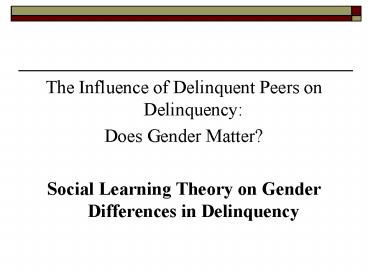The Influence of Delinquent Peers on Delinquency: - PowerPoint PPT Presentation
1 / 21
Title:
The Influence of Delinquent Peers on Delinquency:
Description:
Does Gender Matter? Research on Aggression Relational aggression? Empirical fact Explanations (Cauce et al., 1994; Cotterell, 1996) ... – PowerPoint PPT presentation
Number of Views:174
Avg rating:3.0/5.0
Title: The Influence of Delinquent Peers on Delinquency:
1
- The Influence of Delinquent Peers on Delinquency
- Does Gender Matter?
- Social Learning Theory on Gender Differences in
Delinquency
2
The Influence of Delinquent Peers on
Delinquency Does Gender Matter?
- The association with delinquent peers is an
important predictor of delinquent behavior - At its core, social learning theory assumes that
the general process of delinquency is invariant
across gender - How to explain gender differences in delinquency?
3
Girls in trouble
- http//www.youtube.com/watch?vKzxazCM8N98feature
relmfu
4
The Influence of Delinquent Peers on
Delinquency Does Gender Matter?
- May be there is something unique about male peer
groups in facilitating delinquency?
5
The Influence of Delinquent Peers on
Delinquency Does Gender Matter?
- Boys and girls tend to associate within their own
gender groups - Boys have more delinquent friends than girls
6
Does Gender Matter?
- Girls who spent time in groups with boys are more
likely to engage in delinquent acts than girls
who only associated with other girls - There is evidence that girls learn delinquency
from boys - Similarly, boys learn delinquency from other boys
7
Research on Aggression
- Females use aggression as often as adolescent
males - Unlike boys, girls typically shun physical
aggression, but they use gossip, ridicule,
exclusion and other forms of relational
aggression, particularly toward other females
8
Relational aggression?
- Mean Girls
- Thirteen
9
Empirical fact
- Female-dominated networks discourage crime more
than male-dominated networks
10
Explanations (Cauce et al., 1994 Cotterell, 1996)
- Females have more intimate friends
- Most of these friends are other girls
- Females consistently report that
- they spend more time with friends
- expect and receive more kindness, commitment, and
empathy from them - have more open, intimate, and disclosing
relationships
11
Explanations
- Females favor activities that involve intimate
discussions - A large proportion of males describe a close male
friend as someone who did not express his true
feelings to them and from whom they hid their
feelings - Other research suggests that males may regret the
lack of intimacy in their same-sex friendships
but accept it as the norm (Way, 1996).
12
Gendered Opportunities
- Female friends may further deter crime by
reducing offending opportunities - Female friends tend to meet in places supervised
by parents and other adults, and regardless of
where they meet, spend much of their time talking
intimately
13
Gendered Opportunities
- Male friends spend more time in their routine
activities in public settings away from family
and other supervision - And they are more often engaged in activities
that are impersonal, physical and involve
interactions with strangers
14
Girls who have male friends
- Involvement in antisocial behavior increased for
girls who are affiliated with male friends, and
who know more delinquent peers (Caspi et al.,
1993).
15
Conclusions
- In sum, female friendships clearly differ from
male friendships - Female and male friendships differ in how they
originate and unfold - Female friendships involve more social control
and present fewer opportunities and motivations
for crime.
16
Can friendship network predict delinquency
- Delinquent network
- Non-delinquent network
- Mixed network
17
Mixed network
- When friendship networks contain access to both
delinquent and non-delinquent friends, the
network is less effective in providing clear
behavioral guidelines and consistent values
regarding behavior expectations
18
Employing a Network Perspective
- The friendship network can be mapped out
- We ask respondents to describe their own
behavior and to identify their friends - We locate and interview the friends about their
own behavior and their friends, and so on.
19
(No Transcript)
20
(No Transcript)
21
Employing a Network Perspective
- The results indicate that the proportion of
delinquent friends is the most important aspect
of peer influence - This finding supports Sutherlands (1947) premise
that the ratio of definitions favorable to those
unfavorable to law violations is key to
understanding why adolescents engage in
delinquency































